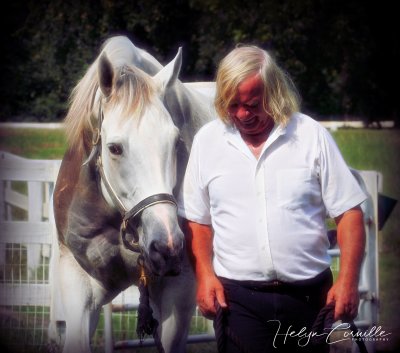The Holy Grail
The Holy Grail

The search for the holy grail commences early in our equestrian life. There is something mysterious, sublime, superior, an absolute lightness and harmony with the horse that is promised in the equestrian literature but not clearly defined and apparently unreachable. For a competitive rider, the holy grail must be the absolute victory, but from local, to regional, to national success, the holy grail remains ahead of us. Maybe it is attainable at world class level. Well, I competed at world class level and realized that I was aiming in the wrong direction.
The holy grail is not at the level of success and associated ego; it is when we meet the horse at his level of subtle perception, absolute willingness and outstanding kindness. The real horse has been curtained from us by the theories of obedience to the aids and submission that have directed our skill and mind away from the relationship that the horse expects from us.
All along, the horse has done it in spite of the archaism of our training techniques and even when the reflexes that we stimulated were contrary to the effort that we requested. We have engaged the horse’s hind legs forward under his belly thinking that the more forward the position of the hind leg at impact, the greater the hind leg’s ability to propel his body upward. There were studies demonstrating that it was indeed the forelegs which produced the greatest percentage of upward forces but the findings did not fit our beliefs and we dismissed them. Horses have performed and continue to perform in spite of our kicking legs and shifts of our body weight. As we think that upward propulsive forces are created during the first half of the stride when the hind legs are forward under the belly, the horse starts the propulsive activity of the hind legs during the second half of the stride as the hind legs move backward behind the body. The first half is the decelerating or breaking phase where the alighting hind legs resists accelerations of gravity storing elastic energy that is used for the following sequence of the stride, the pushing phase. As we think that our driving seat pushes the horse forward, the propulsive activity of the hind legs produces a force in the direction of the motion traveling forward through the thoracolumbar spine. Gravity pulls a percentage of the initial thrust generated by the hind leg down to earth loading the forelegs, and the shift of our body weight accelerate gravity loading even more the forelegs
Our mind imagines specific effects of our actions but the horse perceives totally differently our gestures and shifts of our body weight. The horse has basically to ignore our nuisances and coordinate his physique in spite of our nuisances, and we take the credit when the horse succeeds. Rider’s skill and the horse’s talent find ways to communicate through a third language. I did, all the way to world class level, and realized that I was feeding a system which failed the horse and failed me. “Any intelligent fool can make things bigger, more complex, and more violent. It takes a touch of genius - and a lot of courage - to move in the opposite direction.” (Albert Einstein) The touch of genius is in the inherent intuition of many riders. The courage to move in the opposite direction demands that one liberates oneself from the oppression of the system. Insecurity is a weapon of control as insecure peoples always feel that they are not good enough. The system is a third language which does not allows one and one’s horse to reach their full potential.
Meeting the horse at his level of subtle perception, absolute willingness and outstanding kindness is the first step toward the holy grail. It is a considerable evolution but a fascinating journey. It does not question our physical skill; it uses it for a different conversation. We partner with a willing and imperfect partner who meets difficulties and tries instinctively to protect whatever muscle imbalance, morphological flaw, or even memory which is part of his body state. The horse does not need our judgement; he needs our knowledge and analysis. The horse is willing to explore a different solution if our analysis identifies the source of the difficulty and provide solutions to correct it. Then, the touch of genius which allowed the horse to fill up the blanks of traditional education rises the partnership at a level of intimacy, willingness, and intelligence that the submission to the correct aids never approach. This is the holy grail.
Jean Luc & Chazot


